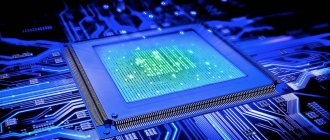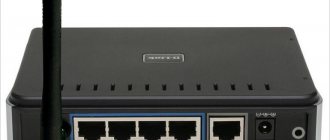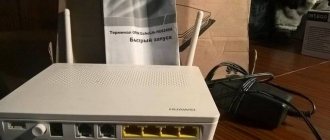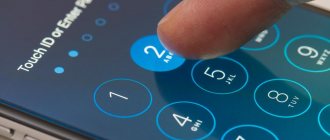Home / Lifehacks / For hardware / Setting up the BIOS in pictures - step-by-step instructions [Author's analysis]
For hardwareLifehacks
January 12, 2022
We explain and show how to configure the BIOS in pictures.
BIOS is low-level software that runs when supply voltage is applied to the power elements of the computer and controls its operation (tests the equipment for faults) before transferring its powers to the operating system loader. It is also called the basic information input/output system. It looks like a set of chips soldered onto the motherboard. In the settings, the user can change a lot of things and save these adjustments, which is realized thanks to a miniature coin battery.
This technology is more than 3 decades old; although it has developed, each revolution has lagged far behind the development of other computer hardware components. However, it is quickly being replaced by a new specification - UEFI. To change the settings, you need to go to the menu using the F2, Del or other key specified in the instructions for the motherboard or laptop immediately after turning on the computer. There are a lot of firmware versions, each hardware developer adapts it to their needs.
Let's look at the example of one of the most common versions of the software shell.
If the menu on the computer is colorful, with a background image, and you can use the mouse in it, then UEFI is used - the next stage in the development of technology, and this instruction is only suitable for familiarization. We also note that the order, name and even the number of sections of the main menu (and even more so the options in its subsections) differ in different firmware versions.
The main menu consists of a number of tabs where relevant information and options are collected, it is a gateway to the world of changing low-level firmware parameters.
Main
The section adjusts the system date and time, the priority of devices for booting the computer, and displays all found devices for storing information (hard drives, removable drives, floppy drives).
“Not detected” will appear near the interface .
Rice. 1- Home page
After going to the drive configuration menu, the following parameters will appear on the display:
- LBA Large Mode - responsible for the memory addressing method. For HDDs up to 504 MB, the direct addressing method was used, and for larger capacities, LBA was used. Set to Auto to automatically detect the drive or LBA.
- Block (IDE HDD Block Mode, Multi-Sector Transfer) – allows you to transfer several pieces of data per unit of time; when disabled, the data exchange speed drops sharply. If the PC is not running Windows NT, select Maximum or the automatic mode for determining the number of transferred sectors per unit of time.
- PIO Mode – switches the HDD to a mode that is no longer used, which will also slow down its operation.
- DMA Mode – direct memory access mode, can be deactivated only in exceptional cases.
- SMART Monitoring – monitoring the condition of the hard drive, allowing you to warn about the occurrence of failures in its operation and bad sectors. If a slight decrease in its performance is critical or there is no important information on the drive, the mode can be disabled.
- 32 Bit Transfer - when activated, a pair of 16-bit words are combined into one 32-bit word before being sent via the data bus; in the second case, the 32-bit words are split in two and transmitted alternately, doubling the data transfer time.
The next item in the section is Storage Configuration. This is where the operation of hard drives changes.
- SATA Configuration – you can deactivate the SATA controller or make it work with older Windows (98 and earlier).
- Configure SATA as – switches between IDE (legacy) and AHCI modes – supports plug-in-play.
- Hard Disk Write Protect – disk write protection is a specific and very impractical option.
- IDE Detect Time out – set a delay before initializing hard drives; an increase is required if problems arise with detecting drives.
Full BIOS settings
- When this option is enabled, Video BIOS is copied to system memory for faster access. Improves BIOS performance because the CPU can now read the BIOS via the 64-bit DRAM bus rather than the 8-bit XT bus. This is all very attractive as it implies at least a 100x increase in transfer speed and the cost of this is in system memory space which will be used to mirror the contents of the ROM.
- enable video BIOS shadowing
(for area C000-C7FF) and - enable shadowing
of remaining portions,
However, modern operating systems bypass the BIOS completely and have direct access to the video card. So there are no BIOS calls and no benefit from BIOS shadowing. In light of all this, there is no point in wasting system memory just to shadow the Video BIOS if it is not being used at all. According to Microsoft's article on Shadowing BIOS under WinNT 4.0, shadowing the BIOS (regardless of what BIOS it is) does not provide any performance improvement since it is not used by WinNT. It will only “eat” the memory. Although the article does not mention anything about Win9x, all this is true for Win9x, since it is based on the same Win32 architecture. Moreover, some manuals mention the possibility of system instability if certain games access a RAM area (region) that has already been used for Video BIOS dimming. However, this is no longer relevant, since this shaded area of RAM has been made inaccessible to programs. What is worth mentioning is that only 32KB is shaded in the video BIOS. Newer video BIOSes are usually larger than 32KB in size, but if only 32KB is shadowed and the rest is left in its original position, then stability problems will begin when accessing the BIOS. Therefore, if you intend to shade the video BIOS, you should make sure that the ENTIRE video BIOS is shaded.
In many cases, only the C000-C7FF area is shaded by default. To fix this you should:
those.
C800-CBFF until the entire video BIOS is obscured. After all, most modern video cards now have Flash ROM (EEPROM) which is significantly faster than older ROMs and even faster than DRAM. Therefore, there is no longer a need for video BIOS shadowing and perhaps even better performance can be achieved without using shadowing at all! In addition, you should not shadow the video BIOS if your video card has a Flash ROM as you will not be able to update its contents if shadowing is enabled.
On the other hand, this option still has some benefits. Some DOS games still use video BIOS because they don't access the GPU directly (although more graphically advanced games do). So, if you play a bunch of different games under DOS, you might want to try enabling Video BIOS Shadowing for better performance. The whole subject of discussion is historical in nature. Back when it was cool to have a VGA video card, graphics cards were pretty dumb and primitive. They were a piece of memory that represented pixels on the screen. To change a pixel, it was necessary to change the memory representing it. Things like changing colors, screen resolution, etc. were performed by writing to a set of registers on the video card. However, everything was done by the processor. Since interfacing with hardware changes along with the hardware itself, the “conversation” with your video card depended on the card you installed specifically. To solve this problem, video cards included a BIOS chip. Simply put, video BIOS was an extension to system BIOS. It was a documented set of functions - requests that a programmer could use to communicate with the video chipset. So why did BIOS shadowing appear? The memory used to store the BIOS on a video card is usually a type of EPROM (Electrically Programmable Read Only Memory). A very fast EPROM has an access time of 130-150ns, which is approximately equal to the memory in an 8086-based computer. Also, the bus bandwidth is 8 bits. As computers got faster (x386, x486, etc.) and games became more graphically intensive, accessing the BIOS became more and more critical. To resolve this issue, we moved the video BIOS to a faster 16-bit system memory to speed things up. In fact, most graphics-intensive DOS games rarely access the BIOS anyway. Most interact with the chipset as directly as possible.
We get: in the old days, video BIOS didn’t really work with a video card. It simply provided a set of functions - queries to make the developer's life easier. New video cards with accelerator functions fall into a completely different category. In fact, their processor is built into the card. In the same way that your system BIOS tells your processor how to run your computer, your video BIOS tells your video processor how to display images. New cards have flash memory, and manufacturers can eradicate any “bug” existing in the firmware. Any OS that uses the accelerator function directly communicates with the processor on the card, giving it a set of commands. Actually, this is the work of the video driver. The idea is that the driver provides the OS with a set of documents with functions - requests. When a call occurs, the driver sends the appropriate command to the video processor. The video processor executes commands as dictated by its programmed video BIOS.
As for shadowing video BIOS, it doesn't really matter. Windows, Linux, or any other OS that uses accelerator functions never communicate directly with the video BIOS. But good old DOS still does it! Therefore, the same functions that once existed in the first VGA cards still exist in the new 3D cards. The performance of the video system depends on how the video interface is written in DOS programs if the video BIOS is shadowed.
Quick summary #2: In today's video accelerators, the main job of the video BIOS is to provide software to the video processor (RIVA TNT2, Voodoo3, etc.) so that it can perform its task. The interface between the video card and the software is provided by a set of commands from the driver and actually has nothing to do with the video BIOS. The original BIOS features are still present for backwards compatibility with VGA.
Advanced
Configuring the main components of the computer hardware.
Rice. 2 – Setting up hardware components
JumperFree Configuration
By selecting the first subsection, we will get to the equipment power management menu.
- AI Overclocking – overclocking the processor: automatically or manually indicating its operating mode.
- DRAM Frequency – manually specifying the operating frequency of the memory bus in asynchronous chipsets.
- Memory Voltage – information about the current voltage on memory modules.
- NB Voltage – current power supply voltage on the chipset controller.
CPU and USB Configuration
A window with information about the central processor, where you can control its operating mode (for advanced users only).
- Onboard Devices Configuration – operating parameters of controllers and interfaces integrated into the motherboard.
- Serial ( Parallel ) Port Address – assigning a specified address to a parallel or Com port.
- Parallel Port Mode – select the operating mode of the parallel port.
In the next USB Configuration window, the settings of the USB ports and controller are changed.
Ways to get into the BIOS
BIOS is the first program that starts when you turn on the power of your computer or laptop. But its operation does not depend in any way on the operating system used. This autonomy is achieved by flashing the program code into the microcircuit included in the motherboard. Therefore, any method that describes how to enter the BIOS on Windows 7 or any other OS requires some actions to be performed before starting to load the OS.
In fact, to access the BIOS you need to press a certain key or a combination of them. Further, depending on the developer of the input/output system and the brand of laptop or computer, the combination options may differ. The following figure shows the standard keys for different brands (the brand name is written in capital letters at the top of the loading screen).
Many computer manufacturers prefer to install their own BIOS versions in their products, to access which different combinations are used.
In fact, there is a prompt on the boot screen indicating which keys you need to press to access the basic functions control program. However, on all modern computers, the loading screen displays for less than a second, so it is often impossible to see this hint.
Moreover, starting with Windows 8 and older, there is an additional way to carry out the procedure in question from the operating system using UEFI mode. To do this, press Win+C, then go to Settings-Change computer settings, then select the General option, and then Special boot options. At the last stage, select Restart now, the computer will reboot and a menu similar to that shown in the picture will appear on the screen. In it you need to select the Diagnostics option.
After this, you need to go to the Advanced options menu
And when finished, activate the UEFI Firmware Settings feature
Then the UEFI interface will open, which is a unified version of the BIOS. Having dealt with this issue, you can move on to the main options for setting up the BIOS .
POWER
Changing the power consumption modes of the computer, configuring the circuit for turning it on and off.
- Suspend Mode – Define a mode to send the system into a power saving state. The best option is S3(STR) or S3 Only - saving the contents of RAM to disk and transferring the rest of the equipment to standby state. Savings will be reflected in increased wake-up time.
- ACPI – finer control of electrical power.
- APM Configuration – without experience you should not come here at all.
Rice. 3 – Power management section
Hardware Monitor
A window containing information from the main equipment sensors: CPU temperature, core voltage, fan speed.
Let's take a closer look at the Standard CMOS Features section
Date and Time
set the working date and time using ,, , , , .
IDE Channel
displays a list of drives connected to the IDE controller of the chipset. The picture indicates that two devices are connected: two hard drives indicating their serial numbers and drive names. And, the numbering of channels and the option for connecting drives are also indicated (Master - main, Slave - slave). I advise you to set the channel detection value to auto.
Drive A and Floppy 3 Mode Support
we set the parameters as in the picture None and Disabled (disabled) - a floppy disk drive, which has long been considered an obsolete device.
Halt On
— select the option to load the OS when errors are detected during initial testing. Personally, I always set it as in the screenshot - All, Buy Keyboard, i.e. if an error is detected, the system writes it and prompts you to press the key (often F1) to continue loading the OS, you can write down the error, go to the Internet to see how it is resolved - reboot and fix it;) There are also two more worthwhile options at this point
All Errors
— your OS will boot if no errors are found.
No Errors
— if errors are detected, your OS will still boot.
Extend Memory
information about the RAM (Random Access Memory) installed in the system.
BOOT
PC boot management.
Rice. 4 – Boot Device Priority
Boot Device Priority
Changing the priority of drives on which the bootloader will be searched to transfer computer control rights from the BIOS to it.
You should intervene only after changing the hardware configuration of the drives or reinstalling the OS on a different partition or media.
Hard Disk Driver
Regardless of the connection interface, you can specify the hard drive number if two or more are connected.
Even a hard drive connected to a SATA3 port can be the first, and one operating via SATA6 can be the second.
Boot Setting Configuration
Control system initialization before Windows starts.
- Quick Boot - disables a full RAM check and other not particularly important tests to speed up PC startup.
- Full Screen Logo – displays a picture with the manufacturer’s logo and hardware data. After shutdown, all POST messages are displayed on the screen.
- Add On ROM Display Mod – changing the order of devices about which information is displayed on the display.
- Bootup Num-Lock – state of the Num-Lock key when Windows starts.
- Wait For ' F 1' If Error – requirement to press F1 to continue starting the PC.
- Hit 'DEL' Message Display – you can disable the hint about which button opens the settings window.
Default BIOS settings on your computer
After connecting your personal friend (computer) to the network, the main OS starts loading, then the hard drive is connected, from which Windows or another OS is loaded. BIOS settings are not automatically enabled on a personal device.
To enter this settings mode, after turning on the computer, wait for a single sound signal or the start of the loading message, and then press the “F2” or “DEL (Delete)” button several times (depending on the motherboard). The correct option is displayed at the bottom of the screen.
After this, the BIOS settings on the computer are enabled by default. The number and names of the main menu items located at the top of the bios settings table may vary. We will look at the main sections and subsections of one of the options for such a menu, which consists of the following items:
- Main - select date, time, hard drives and connected drives.
- Advanced - selecting this item will allow you to select and change modes:
- processor (for example, overclock it);
- memory;
- ports (inputs and outputs) of the computer.
- Power—change the power configuration.
- Boot—change boot parameters.
- Boot Setting Configuration (Boot) - select parameters that affect the speed of loading the OS and the detection of the mouse and keyboard.
- Tools - specialized settings. For example, updating from a flash drive.
- Exit - Exit. You can save the changes and exit bios or leave everything as it was (default).
Security
Security settings.
Supervisor and User Password – lines indicate the presence of a password to access settings as an administrator and user, respectively.
The second one will be able to enter the BIOS settings only in read mode.
Below are forms for setting administrator and user passwords, respectively.
If you forget, you can easily reset them by removing the CMOS battery (the chip where the parameter values are stored) for a few seconds.
Setting up UEFI for installing Windows 7
Unlike the previous procedure, in the modern interface you only need to specify a boot disk or flash drive and start booting from it.
You only need to perform the following few steps:
- Enter the program and click “Exit/Advanced Mode”;
- Next, click “Additional mode”;
- Go to the “Download” tab;
- In the “Change boot” column, click on the external media with the OS (in some modern modifications of the program, you can simply grab the required icon with the mouse and set it to the 1st position);
- That’s it, now the interface is configured, and you can click “Exit”;
- In this case, the PC will immediately start from the specified disk or flash drive;
- Ready. Next comes the standard Windows 7 installation process.
EXIT
Exits the configuration menu to continue loading the operating system.
- Exit & Save Changes – saving the changes made.
- Exit & Discard Changes – closes parameters and rolls back the edits made – no changes will be made to the CMOS memory.
- Discard Changes – cancel changes made during the current session without leaving the BIOS settings window.
- Load Setup Defaults – reset the configuration to the standard one.
Rice. 6 – Exit
Only one of the varieties of outdated BIOS is considered - AMI.
In its other versions, the essence remains the same with some difference in the interface, the absence of several items or the presence of options not inherent to AMI.
What is Bios
First, some terms and theory. BIOS - (Basic Input/Output System) - a basic system that includes preparation for starting a computer and its operating system. In other words, this is a small set of mini-programs that are embedded in a mechanism chip on the motherboard. The most basic and first processes on the computer when the computer is connected to the network, which start this whole machine, begin to work here. They enable the interaction of mechanical devices in a computer.
See how to enter the BIOS and select the boot device.
First of all, when loading, the primary system starts, the BIOS monitors the device for the functionality of all functions, and also launches the operating system from the source specified in the system settings. It could be:
- hard drive (most often);
- flash media;
- CD and/or DVD drive.
The BIOS also displays the heating level of components: processor and motherboard.
Go to the Advanced BIOS Features section
The first item in this section is Hard Disk Boot Priority . This item is intended to select from which media the search for the installed OS will begin. If you have two hard drives installed, you should click on this item, then use the ,, , keys to set the OS search order on the media. Look like in the picture, I naturally put the first one: “Ch0 - primary channel M. - main mode (Master) and after the colon the firm and model of the hard drive ST - seagate380011A” I have the operating system installed on it. You can exit this point or immediately save and confirm.
How to open BIOS on a laptop?
Laptop users also sometimes have to dig into the BIOS. But for those who do not have such knowledge, performing such an operation may seem too difficult. Of course, you need to change any settings carefully, but no difficulties should arise. The login process on a laptop is carried out using hot keys. Their combinations are used less often, but this is also possible. The combination depends not only on the motherboard manufacturer, but also on the manufacturer of the laptop itself. In fact, for this reason, there are special tables that list combinations for opening the BIOS. It's better to print it out, maybe someday this information will come in handy. For example, if the computer freezes and there are no other devices with access to the network, then the previously printed table will come to the rescue.
It is quite clear that in order to make changes to the BIOS settings, you must first find out what functions a particular component has. To do this, you can familiarize yourself with more detailed information. You can find many instructions on the Internet that directly describe the menu of this system. This information will be especially useful for beginners.
Dedicated to how to get into the BIOS
(basic input/output system). Why even get into this Bios? Surely such questions will arise for those who have not yet encountered reinstalling the operating system; in this case, you will need to configure booting not from the hard drive, but from a CD/DVD or USB drive, and this can only be done in the BIOS. Or, for example, your boot sector has been infected by a virus, the system does not boot, and now a wonderful tool from Dr. comes to the rescue. Web is a Live CD anti-virus utility that can only be launched from external media. Blue screens of death can occur due to defective RAM cards. But you can find out whether they are defective or not using the Memtest86 program, which can be downloaded from an external drive. And there are many different features in the BIOS that will be useful to all novice users.
Phoenix TrustedCore Setup Utility
We need to get to the Boot section. Press the right arrow three times:
Here is a list of devices from which you can boot. The line names are different on each computer, but the first two words always tell you what kind of device it is:
- IDE CD – CD/DVD drive
- IDE HDD - hard drive
- USB HDD – portable hard drive
- USB KEY – flash drive.
PC Health Status - section for automatic monitoring of system cooling
Reset Case Open Status
(resetting the case intrusion sensor) - set to Disabled
Below is a sign that you cannot edit, it says the following:
Case Opened
— Yes (the case was opened)
Current CPU Temperature 64 C
- the current temperature of your “stone” - the processor.
Current CPU FAN Speed 2626 RPM
— rotation speed of the cooler that cools the processor.
Current SYSTEM FAN Speed 0 RPM
— the rotation speed of the cooler that cools the mother is 0 in my example, because This fan is not installed.
CPU Warning Temperature
— setting the critical temperature of your “stone”, upon reaching which it will give a signal. For different processors, set their critical temperatures accordingly.
Integrated Peripherals
On-Chip Primary PCI IDE
— this option configures the IDE channel (through which my hard drives are connected throughout the article), naturally Enabled. If your media is connected via new SATA connectors, then Disabled.
On-Chip Sata Mode
— I advise you to set the value as in the picture — auto. The option configures the IDE/SATA chipset controller.
USB Controller
- this function is responsible for the USB controller of your PC, of course Enabled.
USB 2.0 Controller
— this function is responsible for the exchange speed through USB ports, of course Enabled.
USB Keyboard Support
— the option is responsible for supporting USB keyboards at the BIOS level, turn it off.
USB Mouse Support
- the option is responsible for supporting USB - mice at the BIOS level, turn it off.
Legacy USB storage detect
— the option is responsible for identifying and supporting devices connected to the USB port at the BIOS level, enable it.
Azalia Codec
— set auto, thereby enabling the built-in software. sound subsystem board.
Onboard H/W LAN
— integrated network device management option — Enabled.
Onboard LAN Boot ROM
— option to implement installation via the OS network using an integrated network controller, disable.
Onboard Serial Port 1
— COM 1 port option, set to auto.
Onboard Parallel Port
— LPT port option, if the port is not used (very likely) — Disabled.











